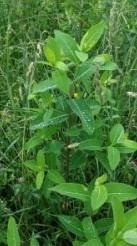
hemp dogbane
Similarities between the two include having creeping roots; leaves that appear on opposite sides of the stem; and they produce a milky sap. Differences include that young milkweed leaves have fine hairs and hemp dogbane are nearly hairless; milkweed stems are generally thick and green, but hemp dogbane stems are usually red to purple and thinner in comparison; hemp dogbane frequently branches in the top canopy, while milkweed will typically not branch unless mowed; and seed pod shape is distinctly different after flowering with milkweed producing an upright tear drop shaped pod and hemp dogbane producing a long bean-like pod that hangs from the plant.
While the usefulness of milkweed in the landscape is often justified for monarch butterfly populations, hemp dogbane has fewer redeeming qualities. Historically hemp dogbane has been used by Native Americans to make rope, clothing, and baskets. Both have the capability of spreading rapidly by their creeping roots and seed production. Both are best controlled in agricultural settings by a combination of strategic mowing and systemic herbicide application.
Both milkweed and hemp dogbane are considered poisonous to livestock. Toxicities can occur from fresh or dried leaves, stems, and roots. While death from poisoning is rare, reduced production efficiency is common if consumed. Symptoms range from mild to severe and include vomiting, diarrhea, coordination loss, tremors, heart problems, respiratory distress, and death.
While eliminating milkweed and hemp dogbane from all ecosystems would be unwise, treatment of some kind is advised in situations where livestock are consuming forage from areas with high populations. Learn more about milkweed and hemp dogbane by comparing the photos provided above or by watching the video from last summer that follows comparing the two plants side by side.
Source : osu.edu